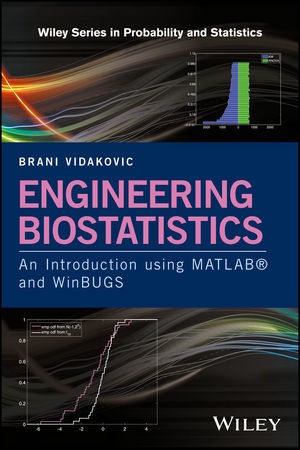Ulteriori informazioni
Provides a one-stop resource for engineers learning biostatistics using MATLAB(r) and WinBUGS
Through its scope and depth of coverage, this book addresses the needs of the vibrant and rapidly growing bio-oriented engineering fields while implementing software packages that are familiar to engineers. The book is heavily oriented to computation and hands-on approaches so readers understand each step of the programming. Another dimension of this book is in parallel coverage of both Bayesian and frequentist approaches to statistical inference. It avoids taking sides on the classical vs. Bayesian paradigms, and many examples in this book are solved using both methods. The results are then compared and commented upon. Readers have the choice of MATLAB(r) for classical data analysis and WinBUGS/OpenBUGS for Bayesian data analysis. Every chapter starts with a box highlighting what is covered in that chapter and ends with exercises, a list of software scripts, datasets, and references.
Engineering Biostatistics: An Introduction using MATLAB(r) and WinBUGS also includes:
* parallel coverage of classical and Bayesian approaches, where appropriate
* substantial coverage of Bayesian approaches to statistical inference
* material that has been classroom-tested in an introductory statistics course in bioengineering over several years
* exercises at the end of each chapter and an accompanying website with full solutions and hints to some exercises, as well as additional materials and examples
Engineering Biostatistics: An Introduction using MATLAB(r) and WinBUGS can serve as a textbook for introductory-to-intermediate applied statistics courses, as well as a useful reference for engineers interested in biostatistical approaches.
Sommario
Preface v
1 Introduction 1
Chapter References 7
2 The Sample and Its Properties 9
2.1 Introduction 9
2.2 A MATLAB Session on Univariate Descriptive Statistics 10
2.3 Location Measures 12
2.4 Variability Measures 15
2.4.1 Ranks 24
2.5 Displaying Data 25
2.6 Multidimensional Samples: Fisher's Iris Data and Body Fat Data 29
2.7 Multivariate Samples and Their Summaries 35
2.8 Principal Components of Data 40
2.9 Visualizing Multivariate Data 45
2.10 Observations as Time Series 49
2.11 About Data Types 52
2.12 Big Data Paradigm 53
2.13 Exercises 55
Chapter References 70
3 Probability, Conditional Probability, and Bayes' Rule 73
3.1 Introduction 73
3.2 Events and Probability 74
3.3 Odds 85
3.4 Venn Diagrams 86
3.5 Counting Principles 88
3.6 Conditional Probability and Independence 92
3.6.1 Pairwise and Global Independence 97
3.7 Total Probability 97
3.8 Reassesing Probabilities: Bayes' Rule 100
3.9 Bayesian Networks 105
3.10 Exercises 111
Chapter References 130
4 Sensitivity, Specificity, and Relatives 133
4.1 Introduction 133
4.2 Notation 134
4.2.1 Conditional Probability Notation 138
4.3 Combining Two or More Tests 141
4.4 ROC Curves 144
4.5 Exercises 149
Chapter References 157
5 Random Variables 159
5.1 Introduction 159
5.2 Discrete Random Variables 161
5.2.1 Jointly Distributed Discrete Random Variables 166
5.3 Some Standard Discrete Distributions 169
5.3.1 Discrete Uniform Distribution 169
5.3.2 Bernoulli and Binomial Distributions 170
5.3.3 Hypergeometric Distribution 174
5.3.4 Poisson Distribution 177
5.3.5 Geometric Distribution 180
5.3.6 Negative Binomial Distribution 183
5.3.7 Multinomial Distribution 184
5.3.8 Quantiles 186
5.4 Continuous Random Variables 187
5.4.1 Joint Distribution of Two Continuous Random Variables 192
5.4.2 Conditional Expectation 193
5.5 Some Standard Continuous Distributions 195
5.5.1 Uniform Distribution 196
5.5.2 Exponential Distribution 198
5.5.3 Normal Distribution 200
5.5.4 Gamma Distribution 201
5.5.5 Inverse Gamma Distribution 203
5.5.6 Beta Distribution 203
5.5.7 Double Exponential Distribution 205
5.5.8 Logistic Distribution 206
5.5.9 Weibull Distribution 207
5.5.10 Pareto Distribution 208
5.5.11 Dirichlet Distribution 209
5.6 Random Numbers and Probability Tables 210
5.7 Transformations of Random Variables 211
5.8 Mixtures 214
5.9 Markov Chains 215
5.10 Exercises 219
Chapter References 232
6 Normal Distribution 235
6.1 Introduction 235
6.2 Normal Distribution 236
6.2.1 Sigma Rules 240
6.2.2 Bivariate Normal Distribution 241
6.3 Examples with a Normal Distribution 243
6.4 Combining Normal Random Variables 246
6.5 Central Limit Theorem 249
6.6 Distributions Related to Normal 253
6.6.1 Chi-square Distribution 254
6.6.2 t-Distribution 258
6.6.3 Cauchy Distribution 259
6.6.4 F-Distribution 260
6.6.5 Noncentral chi2, t, and F Distributions 262
6.6.6 Lognormal Distribution 26
Info autore
BRANI VIDAKOVIC, PhD, is a Professor in the School of Industrial and Systems Engineering (ISyE) at Georgia Institute of Technology and Department of Biomedical Engineering at Georgia Institute of Technology/Emory University. Dr. Vidakovic is a Fellow of the American Statistical Association, Elected Member of the International Statistical Institute, an Editor-in-Chief of
Encyclopedia of Statistical Sciences, Second Edition, and former and current Associate Editor of several leading journals in the field of statistics.
Riassunto
Provides a one-stop resource for engineers learning biostatistics using MATLAB and WinBUGS Through its scope and depth of coverage, this book addresses the needs of the vibrant and rapidly growing bio-oriented engineering fields while implementing software packages that are familiar to engineers.

